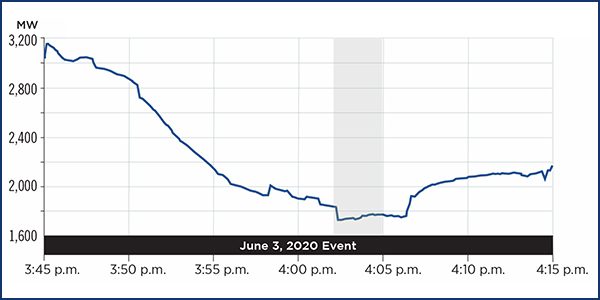The PJM Operating Committee on Thursday unanimously endorsed a “quick fix” solution to give transmission owners access to the Dispatch Interactive Map Application (DIMA), a geospatial situational awareness program that RTO dispatchers have used since 2014.
Ed Kovler, PJM’s senior lead business solutions architect, presented and reviewed the problem statement and issue charge on expanding access to DIMA, which allows operators to see the location of problems on the grid in real time. The quick fix was first presented at the June 4 OC meeting. (See “Dispatch Interactive Map Application,” PJM Operating Committee Briefs: June 4, 2020.)
John Sturgeon of Duke Energy said his company is supportive of TOs having access to DIMA. He asked if there has been any discussion by PJM on the cost of the program and if costs will be passed off to all TOs.
Kovler said PJM had initially considered charging for access to the application, but a decision was made to open it to all TOs at no additional cost. He said costs will be integrated into PJM’s budget.
Tonja Wicks of Duquesne Light Co. asked if confidential information could be added to DIMA and if TOs will be informed by PJM before any changes in information access are made.
Kovler said there are no plans to add any information beyond what has already been demonstrated. The RTO would have to develop a governance process if additional data is added in the future, he added.
PJM plans to present the DIMA issue charge at the July and August Markets and Reliability Committee meetings and the September Members Committee meeting. If endorsed, the Operating Agreement changes will be sent to FERC in September for approval.
COVID-19 Operations Update
Pennsylvania’s move to the “green phase” for reopening from the COVID-19 shutdown has not had a major impact on PJM’s operations, Paul McGlynn told the committee in an update on the RTO’s pandemic operations plan.
McGlynn said most staff continue to telecommute, while control room workers have gone back to a “normal configuration” of two control rooms. He said procedures augmenting operations support staff during critical operating periods have been established.
The current procedures will be in place through at least Labor Day, McGlynn said, and PJM staff will continue to monitor infections in the area and adjust operating plans as needed.
“The PJM plan is flexible and cautious,” McGlynn said.
Stakeholders asked about the year-end deadline PJM instituted for market operations centers that interact with the RTO to operate remotely from their main offices and whether any consideration is being given by the RTO to extending the deadline, as many businesses will continue to operate remotely into 2021.
Mike Bryson of PJM said there were certain compliance concerns regarding keeping the deadline open-ended, but he said extending the deadline should not be an issue if it’s needed.
Synchronous Reserve Review
Rebecca Carroll, PJM’s dispatch director, reviewed the findings from the RTO’s inquiry into why shortage pricing was not triggered during a June 3 incident when synchronized reserves fell short in real time. The report was requested by several stakeholders at the June OC meeting.
Carroll said PJM’s synchronous reserves dipped below the requirement by about 50 MW for about four minutes, from 4:02 to 4:05 p.m. ET.
Real-time security-constrained economic dispatch (RT SCED) case approvals can commit additional reserves to meet the requirement based on the available resources in a 10-minute look-ahead, she said. Real-time synchronized reserves involve an instantaneous calculation of available reserves.
The phenomenon seen on June 3 happens “occasionally,” Carroll said, where generation is either not following the base points sent by PJM or load comes in higher than the forecast. Carroll said the reserves were being fully met by Tier 1 resources at the time and that PJM saw a “significant amount” of Tier 1 generators that were over-generating.
Carroll said generation dispatchers received an alarm the second reserves dipped below the reserve requirement and were able to commit additional condensers to restore the reserves to the requirement.
Gary Greiner, director of market policy for Public Service Enterprise Group, suggested PJM should use both Tier 1 and 2 resources to avoid what happened June 3. “When you have diversity in supply, you can better address situations like this where you’re over-generating,” he said.
Carroll replied that the decision to go with Tier 1 resources is solely based on economics. If there’s enough Tier 1 reserves, she said, the RT SCED engine will use that to solve any problems because it’s the cheapest.
The issue will not exist when Tier 1 is eliminated because of FERC’s ruling in May approving PJM’s proposed energy price formation revisions that consolidate Tier 1 and 2 reserve products, she said. (See FERC Approves PJM Reserve Market Overhaul.)
Black Start Fuel Requirements Update
David Schweizer, PJM’s manager of generation, provided an update on the work plan for the fuel requirements for black start resources. The work was put on hiatus in March pending refining of proposals and costs with stakeholders. (See PJM Backs off Black Start Fuel Rule.)
Schweizer said the intent of additional analysis was to provide further supporting information and to better inform stakeholders regarding the impact of any of the packages proposed.
Technical analysis being done by PJM is focusing on enhancing the previous restoration impact analysis, Schweizer said, which looked at the incremental increase in restoration time analysis if non-fuel-assured black start resources are unavailable during a restoration event.
PJM is also investigating potential gas pipeline and supply issues impacting restoration, Schweizer said, including studying the impacts of the loss of power to gas compressor stations.
Schweizer said work was delayed in the spring because of the COVID-19 pandemic, but PJM hopes to have its analysis done and to restart the stakeholder process by the end of 2020.





